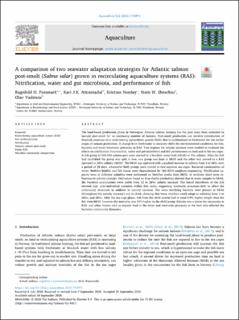| dc.contributor.author | Fossmark, Ragnhild Olsen | |
| dc.contributor.author | Attramadal, Kari | |
| dc.contributor.author | Kristian, Nordøy | |
| dc.contributor.author | Østerhus, Stein Wold | |
| dc.contributor.author | Vadstein, Olav | |
| dc.date.accessioned | 2020-11-09T07:35:33Z | |
| dc.date.available | 2020-11-09T07:35:33Z | |
| dc.date.created | 2020-10-18T17:41:37Z | |
| dc.date.issued | 2021 | |
| dc.identifier.issn | 0044-8486 | |
| dc.identifier.uri | https://hdl.handle.net/11250/2686846 | |
| dc.description.abstract | The land-based production phase in Norwegian Atlantic salmon farming has the past years been extended to include post-smolt for an increasing number of farmers. Post-smolt production can involve introduction of brackish/seawater to a recirculating aquaculture system (RAS) that is acclimatized to freshwater for the earlier stages of salmon production. A change from freshwater to seawater shifts the environmental conditions for fish, bacteria and water treatment processes in RAS. Two regimes for salinity increase were studied to evaluate the effects on nitrification functionality, water and gut microbiota and fish performance on land and in the sea cages. A fish group of 200,000 salmon parr were stocked in a brackish water RAS (bRAS) at 3‰ salinity. After the fish had smoltified the group was split in two, one group was kept in bRAS and the other was moved to a RAS operated at 28‰ salinity (sRAS). The bRAS was operated with a gradual increase in salinity from 3 to 26‰ over a period of 28 days, whereafter both groups were moved to two separate sea cages. Bacterial communities of water, biofilter biofilm and fish faeces were characterized by 16S rRNA amplicon sequencing. Nitrification capacity tests at different salinities were performed on biofilter media from bRAS, to evaluate short term robustness to salinity changes. Ordination based on Bray-Curtis similarities showed that in water samples in bRAS, the bacterial communities were stable from 12 to 26‰ salinity increase. The faecal microbiota of the fish showed high inter-individual variation within fish tanks, suggesting stochastic processes/drift to affect the community structures in addition to salinity increase. The same nitrifying bacteria were present in bRAS (throughout the salinity increase) and in sRAS, showing that these nitrifiers could adapt to salinities from 3 to 26‰, and 28‰. After the sea cage phase, fish from the sRAS system had in total 2.9% higher weight than the fish from bRAS, however the mortality was 15% higher in the sRAS group. Salinity was a driver for succession in RAS, and other factors such as organic load in the water and stochastic processes in the host also affected the bacterial community dynamics. | en_US |
| dc.language.iso | eng | en_US |
| dc.publisher | Elsevier | en_US |
| dc.rights | Navngivelse 4.0 Internasjonal | * |
| dc.rights.uri | http://creativecommons.org/licenses/by/4.0/deed.no | * |
| dc.title | A comparison of two seawater adaptation strategies for Atlantic salmon post-smolt (Salmo salar) grown in recirculating aquaculture systems (RAS): Nitrification, water and gut microbiota, and performance of fish | en_US |
| dc.type | Peer reviewed | en_US |
| dc.type | Journal article | en_US |
| dc.description.version | publishedVersion | en_US |
| dc.source.volume | 532 | en_US |
| dc.source.journal | Aquaculture | en_US |
| dc.identifier.doi | 10.1016/j.aquaculture.2020.735973 | |
| dc.identifier.cristin | 1840379 | |
| dc.relation.project | Regionale forskningsfond Nord-Norge: 289950 | en_US |
| dc.description.localcode | Available online 30 September 2020 0044-8486/ © 2020 The Authors. Published by Elsevier B.V. This is an open access article under the CC BY license (http://creativecommons.org/licenses/by/4.0/). DOI:10.1016/j.aquaculture.2020.735973 | en_US |
| cristin.ispublished | true | |
| cristin.fulltext | original | |
| cristin.qualitycode | 1 | |

